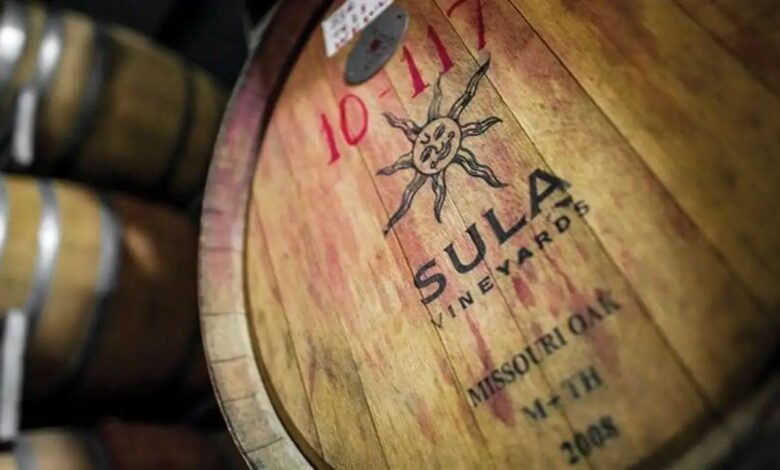The IPO for Sula Vineyards will begin on December 12.

The IPO for Sula Vineyards will begin on December 12.
Sula Vineyards, the largest wine producer in India, is making to deal with its IPO between December 12 and 14, according to different industry individuals with an understanding of the incident who spoke with Moneycontrol. Sula Vineyards is regarded to be a” category maker.” If its listing aspirations are successful, it will be the first pure-play wine company on the Indian stock exchange.

It has been stated, “The situation will open for key investors on December 9 and will be available to the public from December 12 to December 14.” One of the people referenced stated, “The case will be provided to anchor shareholders on December 9 and made available to the general public from December 12 through December 14.”
According to a second source who spoke with Moneycontrol, “Sula Vineyards is hoping to raise between Rs 950 crore and Rs 1,000 crores in the IPO, which will have solely of the OFS element.” Undoubtedly, the public offering has reached 25,546,186 shares, as stated in a DRHP filing by Sula Vineyards in July.
Verlinvest, a customer Belgian family trust that launched its first acquisition over ten years ago and is prepared to participate in OFS, is supporting Sula Vineyards. The organization’s chief executive and chief executive is Rajeev Samant. The i-banks focusing on this problem are IIFL Capital, Kotak Mahindra Capital, and CLSA. DRHP claims that Trilegal and Shardul Amarchand Mangaldas served to be the legal counsel.
Unlisted domestic competitors to Sula Vineyards include Fratelli and Grover Zampa. Another of alcoholic beverage producer that filed a DRHP (draft red flag prospectus) to Sebi later this year and plans to release it in the coming months is Allied Blenders & Distillers, the maker of Officers Choice whiskey.
Sula has two manufacturing facilities—one in Nashik and another in Bangalore—and its headquarters are 180 kilometers northeast of Mumbai. Its capacity was around 13 million liters as of January, with 11 million liters located in Nashik & 2 million liters in Karnataka.

Due to its diversity across several price categories, strong distribution connection, a broad array of wine brands, and major market dominance in the local wine business. It creates 56 domestic brands for consumers under age 13, dividing them into the elite, premium, economy, and mass categories depending on factors like cost, ingredients, flavor, and alcohol concentration. Increased contributions in select and high-end categories are expected to motivate the company’s sales and profit margin in the long run underneath the premiumization plan, per a January 2022 assessment by rating agency ICRA.
Wine has long been linked to prosperity and joy and maintains a special place and sacred offering in different religions. Sula Vineyards, the world’s biggest wine producer in the country, is getting ready to list on the Indian stock exchange./cloudfront-us-east-2.images.arcpublishing.com/reuters/VMNHSFNIHFKHNAA5HKG656YYPU.jpg)
According to Techopak Analysis, which is often cited in DRHP, the Indian alcohol market would account for more than 2.5 lakh crores (INR) or billions of cases (1 case = 9L) in FY2020, putting it one of the largest in the world. In India, the amount of alcohol consumed per person increased from 0.9L in 2000 to 1.6L in 2010 and 2.7L in 2019. The CAGR between 2000 and 2019 is 6%, lower than the CAGR between 2000 and 2010 of 12%.
Spirits, Beer, and Wine are the three main product groups that make up alcoholic beverages. 90% of the booze used in India is consumed by fresh spirits, which is a very unusual consumption pattern. Wine makes explicitly up less than 1%. India has a per capita alcohol consumption of 0.04 liters, compared to a global average of 5.45 liters.
Despite the chance that alcohol consumption has peaked, the amount of room that India’s wine consumption has to catch up to the world average makes the wine industry an intriguing investment chance.
In the 2010–2019 period, the use of each of these market segments went down, but wine has exhibited extraordinary resiliency and spirits the most. On the consumer side, the bulk of the consumption begins to rise in October, continuing through December, before leveling off until the end of the fiscal year. These elements make the wine industry capital- and working-capital-intensive.
Although wine is supposedly manufactured from grapes, the raw material used is exclusively wine grapes. Regular grapes, often known to be table grapes, need a minor production adjustment to become wine grapes. India is home to 140,000 hectares of vineyards, ranking 12th in the world, although just 2% of those are used to make wine from grapes. Revenue mostly depends on how many wines vineyards produce and sell.
The increase in wines has not been fully reflected in sales from operations, which have slowed down during the past three years. While COVID is somewhat to blame, its subsidiary PADPL, which ceased to be a part of Sula in FY21, was primarily responsible for the Beer business‘ demise. Giving up a lucrative market doesn’t make sense unless it’s clear that doing so is part of a more comprehensive strategy to shift away from third-party products and focus on its brands, which will increase profits.
It has reduced the majority of the expenditure heads will be successful. Sula’s innovation has helped it control costs across the value chain, how it is by producing its bottles, adopting stainless steel winemakers, or using screw limits in place of a stopper to prevent leaks.
Excise Duty is still a mysterious piece. State governments have frequently used excise as a low-hanging fruit source of revenue for their state treasuries. In comparison, the pattern over the other few years suggests that the rates are unchanged or declining. Some states now regard wine production (like Maharashtra, Karnataka, UP, etc.) as a horticulture and food processing sector, making it much more likely than other alcoholic beverages to receive government encouragement.
The unusual nature of the process of production is the center of the wine industry. India’s grape harvest season lasts from December to March, and the two states that produce the most wine are Maharashtra and Karnataka. The complete supply for the following fiscal year is made during this harvest season.
The company makes money from the hotel sector in addition to making and selling wine thru the two wine villas, Past Sula and the Sources at Sula. In order to distribute foreign wines and other critical spirits in India, it has distribution partnerships with global companies, including Le Grand Noir, Hardys, & Beluga Vodka.
By giving its distributors a bundle of Sula wine, other internationally known brands of wine, and core spirits, the company has been able to extend its sales distribution network, as per the ICRA study.
The business, which draws more than 50% of its income from the Maharashtra and Karnataka wine industries, works in a highly regulated sector with state-specific regulations that have experienced a rise in the number of foreign competitors.




